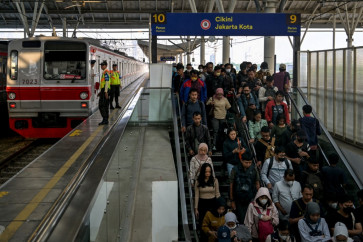Popular Reads
Top Results
Can't find what you're looking for?
View all search resultsPopular Reads
Top Results
Can't find what you're looking for?
View all search resultsChinese New Year: Celebrating ‘Imlek’: It’s all about family
JP/Donny FernandoMost Chinese families around the world typically welcome their New Year with joy and laughter, sharing the festivities with extended family members over what’s said to be the most important dinner of the year
Change text size
Gift Premium Articles
to Anyone
JP/Donny Fernando
Most Chinese families around the world typically welcome their New Year with joy and laughter, sharing the festivities with extended family members over what’s said to be the most important dinner of the year.
Jen Lee, the Hong Kong-based writer of Chinese New Year: A Celebration for Everyone, shares her family’s tradition of watching the Chinese New Year parade, passing on the stories and meanings behind each element with her children. “...The celebrations are a snapshot of Chinese culture. Every food item means something. ... The red envelope of lucky money we give and receive ... is more than just money,” she writes.
There is indeed a lot of meaning behind each tradition in Chinese New Year, which is locally called Imlek. The family dinner, which is the main event of the celebration, is when families gather together for meals and exchange hongbao, or angpao, small red envelopes filled with “lucky money”.
Traditionally held on the eve of Chinese New Year with the mother preparing an eight-course meal, a brunch or lunch is also common today, as long as it is an occasion for family members to sit down and share stories with one another. After the meal, elders give angpao to the young children, or to unmarried or unemployed members of the family. This tradition is intended to encourage children to save and to use money wisely.
Modern families often opt to have their reunion dinner at a hotel or restaurant that offers a special set menu for the holiday, including the traditional yee sang, dumplings (jiaozi) and nian gao. These dishes bring their own philosophies to the New Year. Yee sang, sometimes written yusheng, is an absolute must on a Chinese New Year special menu.
Yee sang is the “prosperity salad toss”, consisting of raw fish and shredded vegetables, and dates back to ancient China. Contemporary yee sang is more than just a salad, with different colored vegetables added to the dish, as well as a special sauce for mixing. The salad is served alongside Chinese New Year greetings and tossed together by different family members at the dinner.
Fish (yú) is an important ingredient because it is a homophone with the Chinese word for abundance, also pronounced yú. A set menu served for Imlek dinner and brunch, however, might also include other seafood such as abalone, king prawn and lobster as one of the main courses.
Jiaozi dumplings are more than just a traditional dish on Chinese New Year. They symbolize wealth, because its shape is similar to that of the yuanbao, or the boat-shaped gold ingots that was part of ancient Chinese currency. Families will typically make homemade dumplings as a dinner activity, sharing the task of filling, wrapping and shaping the dumplings.
Meanwhile, the nian gao sticky rice cake is sold in different shapes and flavors. Aside from serving them as a dish, restaurants and bakeries will offer the fancy-looking ones as gifts to take home. Whether sweet or savory, the meaning behind the nian gao is about raising oneself toward prosperity a step at a time, and thus promises a better year ahead.
Imlek is also the right time to introduce the Chinese culture to the younger generation. Originally performed as part of outdoor parades, the lion and dragon dances have today made their way into malls across Jakarta.
Different shopping malls feature different arts, dances, competitions and performances around the theme of Chinese New Year, but the lion dance, better known as barongsai, is arguably one of the most popular among them. Taking children to watch these performances, which have become more common since the reform era, are now a custom for families during the Chinese New Year holiday season.
The lion dancers usually perform the acrobatic feat of plucking a green ball or a head of lettuce hung high above, with a red envelope as a reward. The noise from the drums and cymbals that accompany the dance is meant to cast off evil spirits. Some hotels and restaurants also feature the performers as special entertainment for their Chinese New Year dinner program.
Chinese New Year goes beyond the first day of the lunar month, as it is traditionally 15 days long and ends with the Lantern Festival. The first three days involve setting off fireworks, visiting family members and burning paper offerings. The Chinese New Year holiday lasts at least three days in several countries, with businesses returning to normal on the fourth day.
The day of the Lantern Festival, which is locally known as Cap Go Meh, is marked by eating tang yuan, the sweet soup filled with glutinous rice balls, and families carry lighted lanterns into the streets. Cap Go Meh is celebrated widely today, especially in cities like Singkawang, West Kalimantan, where the festival has become an annual tourist attraction.
The celebrations that mark Chinese New Year are always about family. Whatever is on the agenda for the upcoming long weekend, welcoming the Year of the Dog is better done together, sharing memories and meaning with loved ones.










